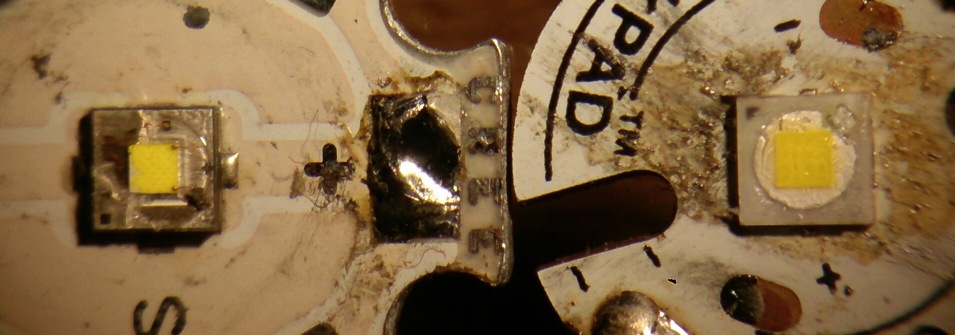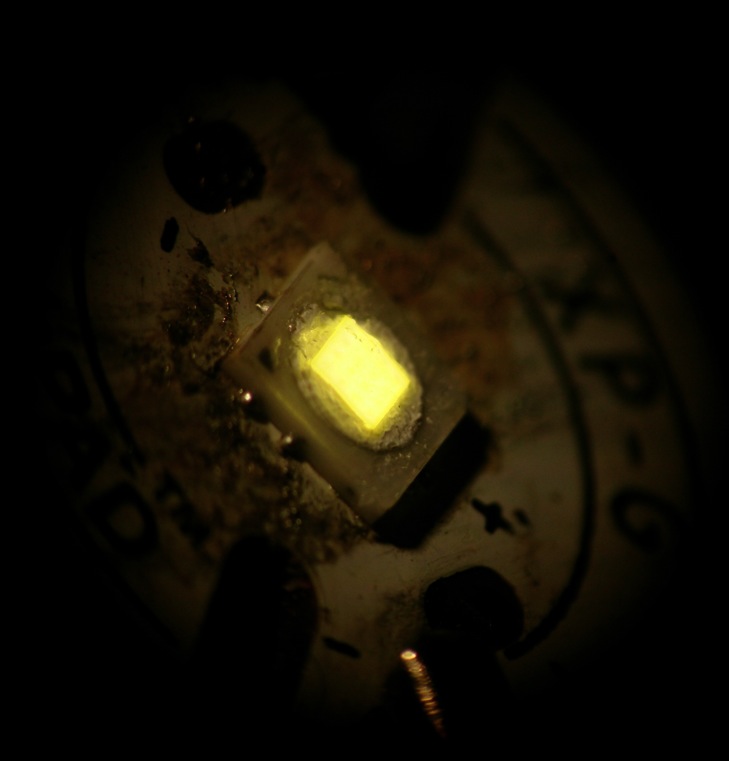I am still confused about which 219B is which, Illumination Supply had supposedly the best tint and bin of the new Nichia219B 4500K 92CRI, but Kaidomain also showed up with some new Nichia 219B's, with mistakes in the type nrs. IS was directly sold out, I ordered the KD one, and also a 5500K (non-highCRI) one. These are my tests. The subjects (the first two are the same led type):

In the description further in this post I just stick to the type nr. of Kaidomain, I will update if I know anything for sure.
This new 219B looks a bit different from the 219A I was used to, the most important difference (apart from performance of course) is that it has a more shallow dome (most of the Nichia 119 and 219 leds have this shallower dome also), actually it is more comparable to a XP-G2 now. You can see that reflected in the emitting angle, it went up from 110 degrees to 120degrees. (left old, right new):

As usual I test output and voltage at various currents with the leds on 16mm Sinkpads mounted on a aluminium block, with a reflector on the led, not extemely accurate, but good for a general idea .I think at least I can compare results well to my earlier results with other leds. I ran out of Sinkpads so these are second hand and quite dirty, I guess they still work alright:

These new Nichia's test very well, but, as I can not measure it, I can not guarantee that the colour temperature and CRI of the leds, as given by the Kaidomain site, are correct (as I understood, Kaidomain is notorious for wrong descriptions). However, as far as I can guess by eye (I have seen a lot of led tints), the high CRI one could really be high CRI (nice tint and colour reproduction), although the tint is a tiny bit cooler than the 'old' Nichia 219A 92CRI, when compared directly (if I mount it in a flashlight one of these days, I can see it better). For real answers on tint and CRI maybe we should ask texaspyro for some thorough colour testing of this led on his fancy equipment?
In the 'high CRI' graph I compare the 92CRI 219b to the old 92CRI 219A (measurements from some time ago) because that is the most interesting comparison. In the 'cool white' graph I compare the 5500K 219b to the XP-G2 R5 0D-tint (measurements from some time ago) because that would be its closest competitor. Here they are:

If this led is the real thing (4500K and 92CRI), it performs way better than the old 219 in every aspect: considerably higher output at any current (up to 3.4A not that far from a cool white XP-G2 actually), it reaches maximum at a higher current, and the voltage is way lower, lower even than the xp-g2.
The Nichia 219 5500K compared to Cree XP-G2:

Also this is impressive, up to 3.2A its output is a bit over the XP-G2 R5, but at a lower voltage :-) . Up to 3.4A the Nichia is more efficient than the Cree, and current regulation in a single Li-ion flashlight will be easier. The XP-G2 is still lord and master at the higher currents, so for the extreme flashlight builds it will be around for a while.
But does the Nichia dedome? I had a go some time ago on a 219A 92CRI led and that dedome worked ok, but a shiny thin layer of silicone was leftover on the die. Well, this time it went no different. I heated the 5500K 219b board up on my heatblock 'till the solder melted, took the board off, pushed it down with a piece of cardboard, cut the dome in from the side with a scalpel and popped the dome slowly off. Same stiff silicone as the other 219 I dedomed, much stiffer than Cree. Some silicone was left on the die, tried to remove some of it with a scalpel, but not everything came off. So this Nichia does not dedome as neat as the Cree dies (perhaps the gasoline methos works a bit better??), but the dedome was done and the led still works. First a comparison of the die size with a dedomed xp-g2 (the Nichia die is bigger, not promising for throw..), and then the die at 10mA, the tint has turned a bit greenish  .
.

Photoshopped: 

Next is build it in a C8 pill at 3A for a real life test. Hang on, that may take a week, I'm busy and tired...
And I guess after confirmation of the CRI (how? :-( ), it is also time to rebuild my 1x18650 Nichia 219 high CRI triple for some more than doubling the output....